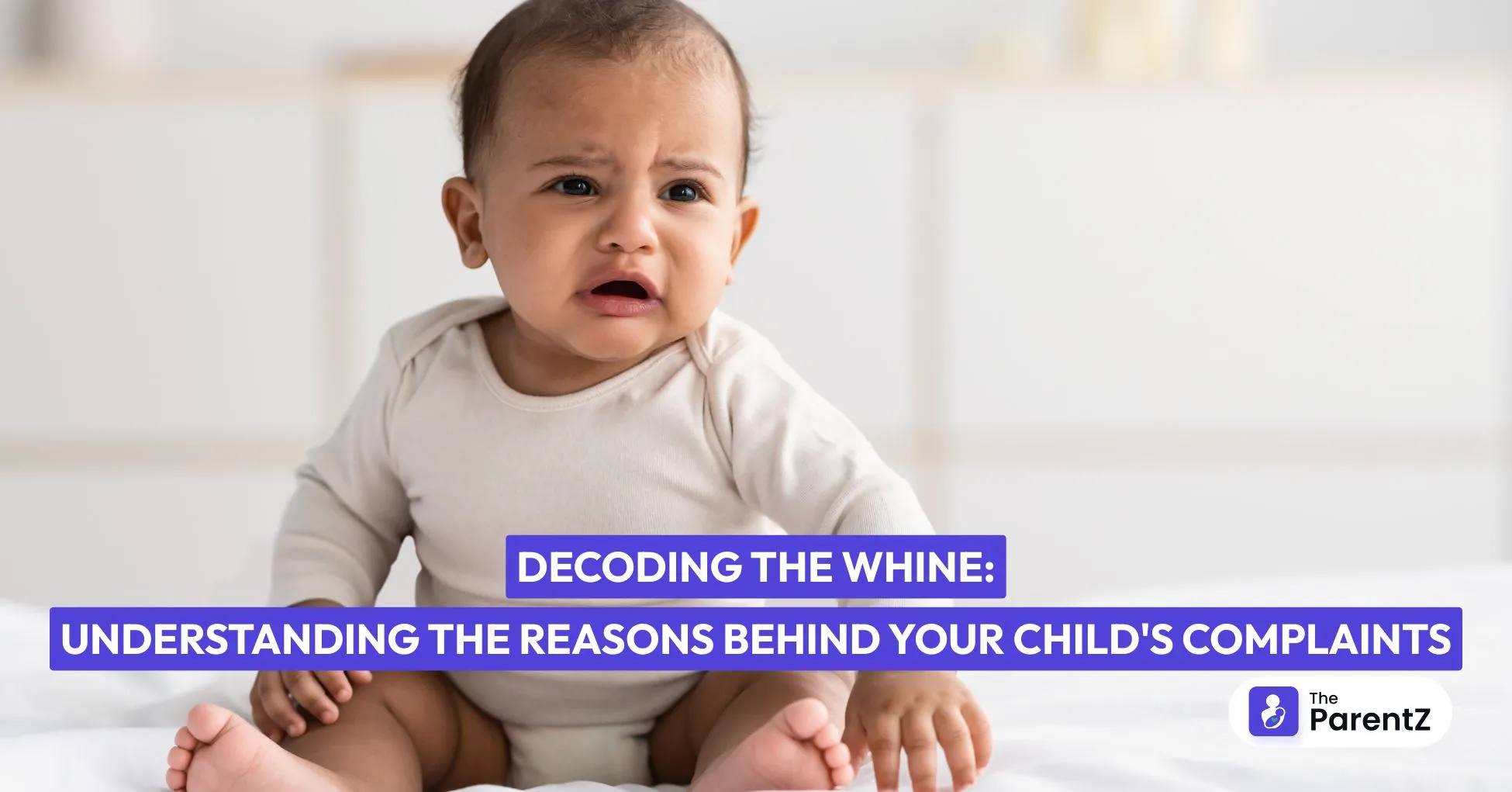Picture this: You're trying to finish making dinner, your phone is buzzing with work messages, and suddenly it starts—that sound that makes your shoulders tense instantly. "Mooooom, he's looking at meeeee!" or "I don't liiiike this!" Your child's whine can feel like nails on a chalkboard after a long day.
Many parents have been there, watching their 4-year-old whine nonstop through an entire grocery trip. By checkout, they're ready to leave the cart and run for the hills. If you've ever felt your blood pressure rise at the first hint of that particular tone in your child's voice, you're not alone.
Not All Whines Are the Same
You’ve probably noticed that whining isn’t just one sound; it comes in many forms. Some whines are soft and pleading, others are loud and demanding. There are tired whines, hungry whines, “I need attention” whines, and even “I don’t know what I need” whines. Each type is a clue to what’s really going on inside your child’s mind and body.
1. The Tired Whine
How it sounds: Low energy, usually accompanied by rubbing eyes, slower movements, and a slight drag in their voice. Think "I don't waaaaanna" with droopy eyes.
What it means: Your child is running on empty. Their brain literally doesn't have the energy to process emotions or communicate properly.
Why it happens: Kids often push through tiredness until they crash. Unlike adults who might recognize they need rest, children fight sleep and then fall apart.
2. The Hungry Whine
How it sounds: Irritable, impatient, with a sense of urgency. Often includes complaints about everything being "wrong" or "not fair."
What it means: Blood sugar is dropping, and your child can't regulate emotions as a result.
Why it happens: Children burn through energy quickly and may not recognize hunger until they're already cranky. The time between "I'm fine" and "I'm starving" can be minutes for some kids.
3. The Attention-Seeking Whine
How it sounds: Repetitive, gets louder when ignored, often stops temporarily when you look their way.
What it means: "I need a connection with you right now."
Why it happens: Kids often whine when they've been feeling disconnected or when they've learned it's the most effective way to get your attention.
4. The Overwhelmed Whine
How it sounds: Higher pitched, might include some tears, complaints about things being "too hard."
What it means: Your child is feeling flooded with emotion or facing a challenge that feels beyond their abilities.
Why it happens: Children have limited coping skills for big feelings or difficult tasks. When their toolbox is empty, whining is the overflow valve.
5. The Habit Whine
How it sounds: Almost automatic, happens even when needs are met, often used before attempting any other communication method.
What it means: "This has worked for me before to get what I want."
Why it happens: If whining has successfully gotten results in the past, your child will naturally use this strategy again.
Why Are Whines Different?
Kids whine for different reasons because their needs and emotions are complex. Their brains are still developing, and they don’t always know how to express what’s wrong. Whining is their way of saying, “Help me!” or “Notice me!” It’s not about being annoying or manipulative; it’s about communication.
Whining is also effective. Studies show that we pay more attention to whining than to neutral speech, so kids learn that it works to get what they need. But if whining doesn’t get results, it can escalate into bigger behaviors like tantrums or screaming.
How to Tell the Difference (Real Parent Detective Skills)
Figuring out which whine you're dealing with requires looking beyond the sound and checking:
- Timing: Is it near naptime or bedtime? (Tired) Close to mealtime? (Hungry)
- Recent attention: Have you been busy or distracted lately? (Attention-seeking)
- Body language: Rubbing eyes or sluggish movements? (Tired) Tense shoulders or widened eyes? (Overwhelmed)
- What happened just before: New situation? Change in routine? Difficult task? (Overwhelmed)
- Pattern: Does the whining stop soon after eating or resting? Does it happen mainly when you're on the phone or busy? These clues tell you what need is behind it.
Responding to Each Type of Whine (Without Losing Your Mind)
For the Tired Whine:
- Skip the lecture and move straight to helping them rest.
- Use phrases like "Your body needs some rest to feel better."
- Create a calm-down corner with soft blankets and stuffed animals.
- Sometimes, a 10-minute quiet time can reset their system.
Pro Tip: Don't try to reason with an exhausted child. Their brain literally can't process it. Handle the tiredness first, then address any behavior issues later when they're rested.
For the Hungry Whine:
- Keep protein-rich snacks easily accessible.
- Respond with "Let's get some food in your belly and then talk."
- Carry emergency snacks in your bag, car, and pockets—this is essential.
- Help them recognize their hunger signals before they crash.
Pro Tip: Many parents learn to carry cheese sticks in coat pockets all winter because their children can transform from angels to gremlins in minutes when hungry. There's no shame in the snack game.
For the Attention-Seeking Whine:
- Schedule regular one-on-one time (even 10 minutes helps).
- When they whine, calmly say: "I can't understand that voice. When you're ready to talk in your regular voice, I'm ready to listen."
- When they do use a normal voice, respond quickly and positively.
- Give attention proactively before the whining starts.
Pro Tip: Setting a timer for 10 minutes of "special time" where the child leads the play can fill their connection cup and reduce whining for hours afterward.
For the Overwhelmed Whine:
- Acknowledge the feeling: "This feels really hard right now, doesn't it?"
- Break tasks into smaller steps.
- Offer help, but don't take over completely.
- Teach coping phrases like "I can do hard things" or "I need a breather."
Pro Tip: Sometimes kids just need to hear "Yeah, this sucks right now" to feel understood before they can move forward.
For the Habit Whine:
- Be consistent in not rewarding whining.
- Calmly explain: "I only respond to regular voices. Try again, please."
- Praise normal communication immediately.
- Role-play better ways to ask for things.
Pro Tip: Breaking a whining habit takes time and consistency. There will be days you slip up. Tomorrow is another chance.
Moving Beyond the Whine
The ultimate goal isn't just stopping the whining – it's helping kids develop better emotional skills:
- Name feelings: "It sounds like you're frustrated because..." Giving feelings names helps kids learn to identify them.
- Model healthy communication: Children are watching how parents handle their own frustrations.
- Praise progress: "I noticed you asked for help without whining. That made it easy for me to understand what you needed!"
- Create a signal: Many families develop a secret hand signal that means "you're starting to whine." It becomes a private reminder without embarrassment.
- Be patient: Learning emotional regulation takes years (some adults still struggle with it).
When your child stops whining, don't just move on. Take a second to connect, maybe offer a hug or a high-five. This positive reinforcement helps cement the better communication style.
When to Worry
While whining is normal, sometimes it signals something deeper:
- Whining that increases dramatically or suddenly
- Complaints about the same bodily pain repeatedly
- Whining that interferes with normal activities for weeks
- Significant personality changes alongside the whining
These might warrant a conversation with your pediatrician to rule out physical issues or anxiety.
Conclusion
Whining is a normal part of childhood. By listening to the different kinds of whines, understanding the reasons behind them, and responding with empathy, you can help your child grow into a confident, emotionally healthy person. The next time you hear that familiar sound, take a moment to decode the message; your child is counting on you to hear them, not just the noise.









Be the first one to comment on this story.